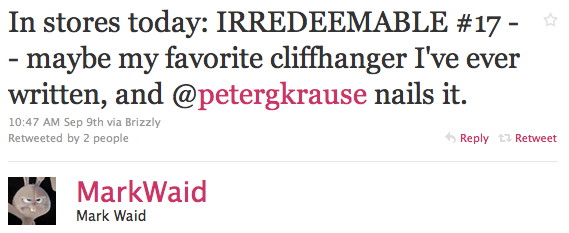- Astro City: The Dark Age vol 2 HC, by Kurt Busiek, Brent Anderson & Alex Ross (DC/Wildstorm)
- Batman Beyond #5 of 6, by Adam Beechen, Ryan Benjamin & John Stanisci (DC)
- Batman and Robin #15, by Grant Morrison & Frazer Irving (DC)
- DC Universe: Legacies #6 of 10, by Len Wein, Scott Kolins, Jerry Ordway, George Pérez, Scott Koblish, Keith Giffen & Al Milgrom (DC)
- Fables #99, by Bill Willingham & Inaki Miranda (DC/Vertigo)
- Green Lantern Corps #53, by Tony Bedard, Tyler Kirkham & Batt (DC)
- Legion of Super-Heroes #6, by Paul Levitz, Francis Portela, Phil Jimenez, Scott Koblish, Yildiray Cinar & Wayne Faucher (DC)
- Power Girl #17, by Judd Winick & Sami Basri (DC)
- Steve Rogers: Super-Soldier #4 of 4, by Ed Brubaker & Dale Eaglesham (Marvel)
- Morning Glories #3, by Nick Spencer & Joe Eisma (Image)
- The Sixth Gun #5, by Cullen Bunn & Brian Hurtt (Oni)

|
I was rather perplexed at the end of the previous issue of Batman Beyond, but this issue does a fine job in clearing up my confusion, and making sense of the identity of the new Hush – he’s a clone of Dick Grayson, the same way Terry McGinnis is a clone of Bruce Wayne. Part of the problem is that Ryan Benjamin and John Stanisci’s art is often not very clear, trying to look a little like the cartoon series but with a heavy dose of latter-day Frank Miller in their style (which in my opinion is not a good thing). In this issue they draw Hush in a strong Miller-esque style, which makes his emotions and identity very difficult to read. It just seems sloppy, really.
(Although, I wonder if the Miller-like art is an homage to The Dark Knight Strikes Again, in which an older Bruce Wayne deals with a psychotic Dick Grayson. The parallel is passingly interesting, but since TDKSA was basically self-indulgent drek, it’s not really a selling point for this series.) The series has been something of a mixed bag, but ultimately it’s been fun despite its flaws. I look forward to the wrap-up next month. |

|
That cover has almost nothing to do with the latest issue of Legion of Super-Heroes, just a couple of pages where people talk about the fact that Shadow Lass slept with Earth-Man (is she not still with Mon-El? How confusing). But otherwise it features two stories, one mostly involving moving characters around (Levitz loves writing these little in-between bits which don’t really advance the plot), and the other featuring members of the Legion Academy. It’s a filler issue.
But then there’s the last page: So whom should I vote for in the Legion leader election? Element Lad’s always been my favorite – except I can’t stand his pink costume, especially since it replaced the excellent Dave Cockrum-designed blue-and-green one. Among the candidates, I think I’d go with either Mon-El or Dawnstar. |

|
Steve Rogers: Super-Soldier wraps up with a nifty confrontation between Steve and Machinesmith, and a neat coda which puts a rather different spin on the rest of the series, leaving our hero confused as to what exactly was going on. As with Brubaker’s Captain America run, this has been quite good. But it kind of underscores that Steve Rogers really needs to be Cap; Bucky has been a decent fill-in, but it’s becoming clear that he doesn’t have the temperament or skills to really be Cap, that his road leads elsewhere.
With “The Trial of Captain America” right around the corner, I hope these points get handled over the next year. |





























